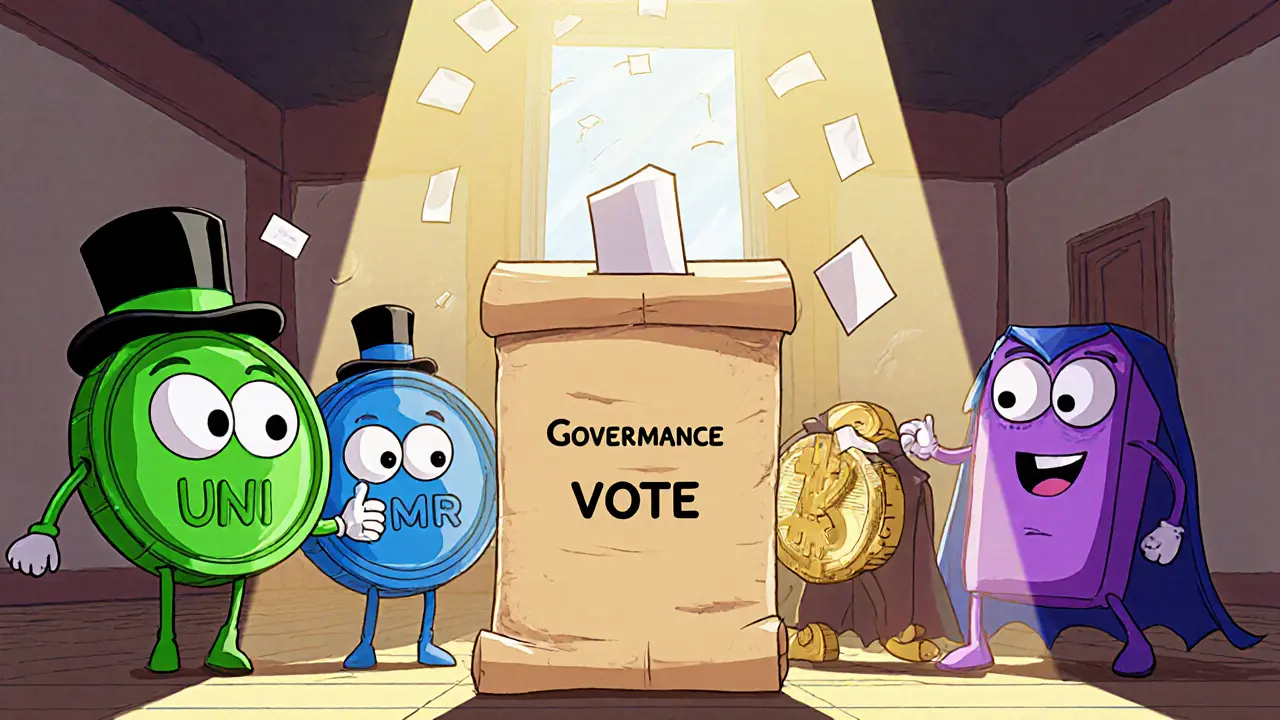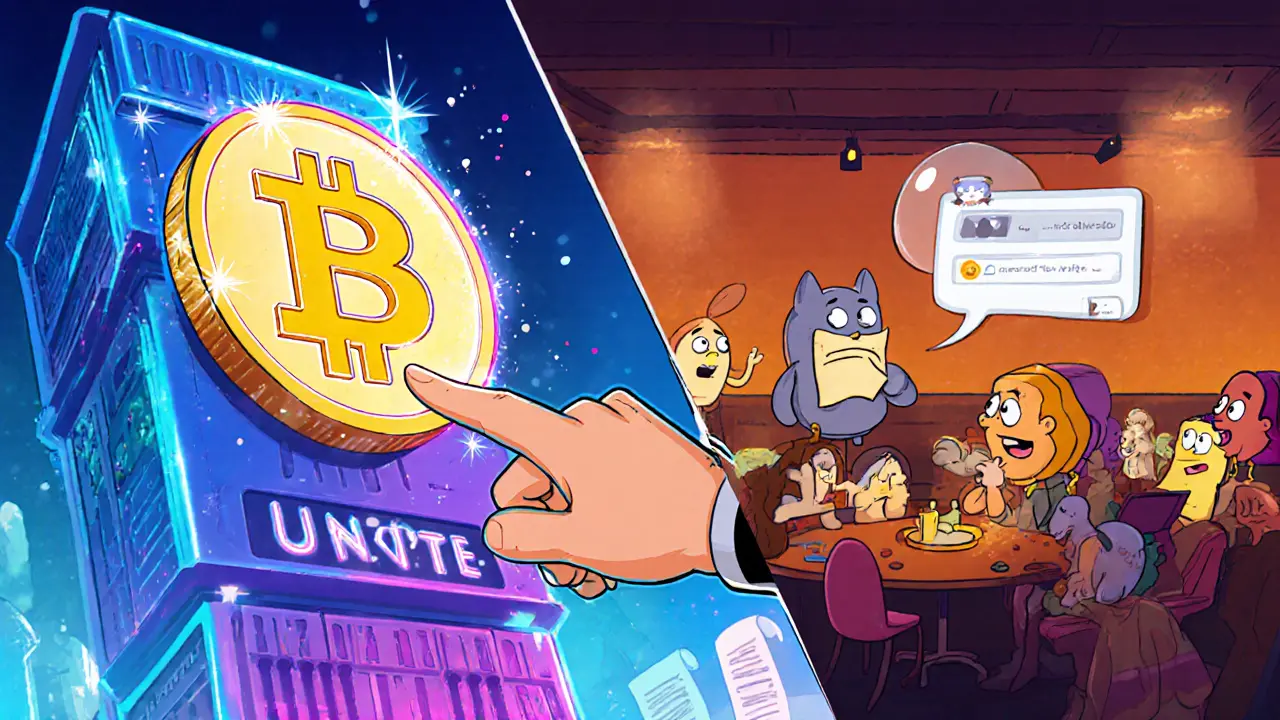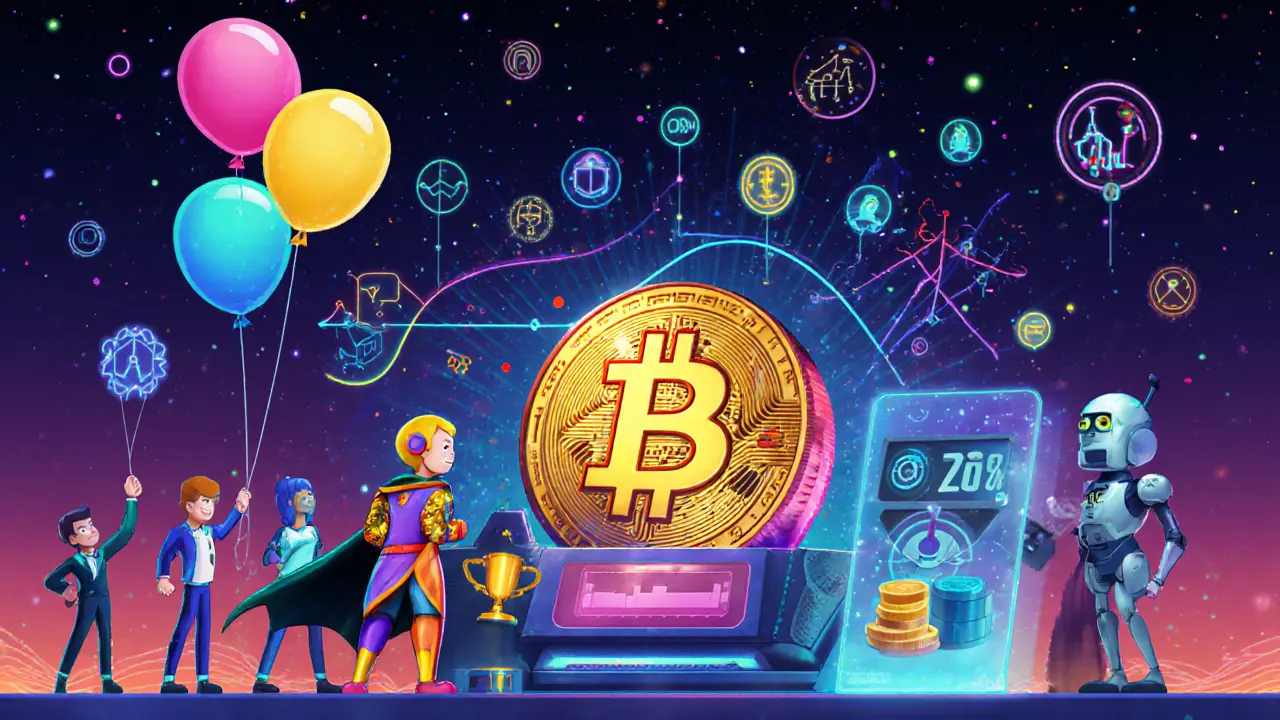
DeFi Governance Explorer
Explore how major DeFi protocols use governance tokens to make decisions. Select a protocol below to learn more about its governance model.
Uniswap (UNI)
Governance TokenVoting on fee structures, token listings, treasury allocations
Compound (COMP)
Governance TokenInterest rate adjustments, collateral factors, new markets
MakerDAO (MKR)
Governance TokenStablecoin Dai risk parameters, collateral types, stability fees
Aave (AAVE)
Governance TokenLending pool parameters, insurance funds, protocol upgrades
Governance Model Comparison
| Aspect | On-Chain Governance | Off-Chain Governance |
|---|---|---|
| Execution | Votes recorded on blockchain | Votes happen off-chain, recorded on-chain for final tally |
| Cost | Higher gas fees | Lower cost, reduced gas fees |
| Transparency | Full public record | Discussions off-chain, votes on-chain |
| Examples | Compound, Uniswap | Snapshot, Discord |
Key Takeaways
- The core idea behind token-based governance is that crypto tokens confer voting rights over protocol decisions.
- Two main architectures exist: on‑chain voting via smart contracts and off‑chain coordination on platforms like Discord or Snapshot.
- Major DeFi projects (Uniswap, Compound, MakerDAO, Aave) illustrate real‑world implementations and challenges.
- Advantages include transparency and stakeholder alignment; challenges involve voter apathy and plutocracy.
- Future innovations-quadratic voting, bicameral models, AI‑assisted proposal analysis-aim to boost participation and decision quality.
What Exactly Is a Token‑Based Governance System?
When we talk about Token-Based Governance Systems decentralized decision‑making frameworks that use crypto tokens to assign voting power in blockchain projects, we’re describing a model that’s reshaping how protocols evolve without a central board. In practice, a Governance Token a specialized cryptocurrency that grants its holder voting rights on protocol proposals serves as the key credential. Holders can vote, propose changes, or delegate their voting power to trusted community members.
This approach emerged alongside the rise of Decentralized Autonomous Organizations (DAO a collectively‑owned organization governed by smart‑contract rules) and has become a cornerstone of modern DeFi ecosystems.
On‑Chain vs. Off‑Chain Governance: Two Technical Paths
On‑Chain Governance executes voting directly on the blockchain. Each token typically equals one vote, though some protocols use weighted or quadratic formulas. A proposal is submitted as a smart‑contract transaction, votes are cast on‑chain, and once the quorum passes, the contract executes the change automatically. Examples include the Governor Bravo contract used by Compound a lending protocol that lets COMP holders vote on protocol upgrades and Uniswap’s V3 upgrade process.
Off‑Chain Governance happens outside the ledger, often on community platforms such as Discord, Telegram, or specialized voting tools like Snapshot an off‑chain voting system that records signatures on‑chain only for final tallying. Off‑chain discussions shape proposal language, gather feedback, and coordinate voting schedules. The final vote may still be recorded on‑chain for legitimacy, but the heavy lifting occurs off‑chain, reducing gas costs.

Real‑World Implementations: Tokens That Put Power in Users’ Hands
Below are four flagship projects that illustrate how token‑based governance works at scale:
- UNI (Uniswap) governs the Uniswap protocol, allowing token holders to vote on fee structures, token listings, and treasury allocations.
- COMP (Compound) empowers token holders to propose interest‑rate adjustments, collateral factor changes, and new market additions.
- MKR (MakerDAO) governs the stablecoin Dai, with token holders voting on risk parameters, collateral types, and stability fees.
- AAVE (Aave) controls lending pool parameters, insurance fund allocations, and future protocol upgrades.
Collectively, these tokens lock billions of dollars in value, proving that token‑based governance can manage high‑stakes financial systems.
Why Token‑Based Governance Beats Traditional Corporate Models-And Where It Falters
| Aspect | Token‑Based Governance | Traditional Corporate Governance |
|---|---|---|
| Decision‑making body | All token holders (or delegated voters) | Board of directors & executives |
| Transparency | Votes recorded on public ledger; fully visible | Often confidential; limited shareholder insight |
| Speed of change | Can be minutes to weeks depending on voting period | Weeks to months, subject to regulatory filings |
| Incentive alignment | Token value directly tied to protocol outcomes | Executive compensation may not align with shareholder value |
| Risk of plutocracy | Large holders can dominate voting power | Shareholder concentration can also influence outcomes |
| Participation rates | Often 30‑40% active, many silent holders | Typically higher due to fiduciary duties and proxies |
The table highlights that while token‑based systems excel in openness and speed, they still wrestle with low voter turnout and the danger of wealth‑based dominance.
Getting Started: A Practical Guide for New Token Holders
- Acquire the governance token via a reputable exchange or by providing liquidity on the protocol.
- Connect a compatible wallet (MetaMask, Ledger, or WalletConnect) to the protocol’s governance dashboard.
- Familiarize yourself with the proposal format - most platforms use a standard template covering title, rationale, and on‑chain actions.
- Start by voting on low‑stakes proposals to learn the process without risking capital.
- If you hold a large amount, consider delegating part of your voting power to a trusted community expert to mitigate voter fatigue.
- Stay updated via official Discord, Telegram, and forums; many projects post weekly summaries of upcoming votes.
- Review security audits of the governance smart contracts - a vulnerable voting contract can expose the entire protocol to attack.
These steps reduce the learning curve, which can range from a few hours for simple voting to months for full proposal authorship.
Emerging Trends: Making Token‑Based Governance More Inclusive
Researchers and developers are experimenting with several innovations to address participation gaps:
- Quadratic voting - each additional vote costs exponentially more tokens, limiting the sway of whales.
- Bicameral models - Optimism’s recent upgrade pairs token voting with a reputation‑based "citizen" chamber, diversifying decision sources.
- AI‑assisted proposal analysis - early‑stage tools scan code changes, estimate economic impact, and surface risk flags for voters.
- Cross‑chain governance - protocols aim to let a token holder cast a single vote that influences multiple blockchains via interoperability bridges.
- Gamified interfaces - leaderboards, achievement badges, and token‑earned rewards encourage more frequent participation.
These designs aim to balance the democratic ideals of token‑based governance with the practical need for efficient, secure decision‑making.

Frequently Asked Questions
What is the difference between a governance token and a regular utility token?
A governance token explicitly grants voting rights on protocol proposals, whereas a utility token mainly provides access to a service (e.g., paying fees) without direct influence over governance decisions.
How can I participate if I only own a small amount of tokens?
Small holders can still vote; many projects accept any token amount. Delegating to a reputable voter or joining a voting pool can amplify your voice while keeping control of your tokens.
Are governance tokens considered securities?
Regulators worldwide are still debating the classification. Some jurisdictions treat them as securities if voting power equates to control over a financial asset, while others view them as utility tokens. Investors should monitor local regulations before buying large amounts.
What happens if a governance proposal fails?
A failed proposal simply does not execute; the protocol remains unchanged. Failed votes can provide valuable community feedback and help refine future proposals.
Can I withdraw my governance tokens after voting?
Yes. Tokens are typically locked only for the duration of the voting period. Once voting ends, you can move or stake them as you wish.

Bobby Ferew
June 13, 2025 AT 05:42Tokenomics has become the lingua franca of DeFi governance, and it's intriguing how every forum post seems to masquerade as a deep dive into liquidity mining while skimming over the actual voting mechanics.
On‑chain quorum thresholds are often set so high that the average user feels compelled to stay silent, which, frankly, is a subtle form of gatekeeping.
The jargon-heavy discussions can feel like a warm hug for the initiated and an icy stare for newcomers.
Yet the community still applauds these opaque processes, as if complexity equates to credibility.
In reality, the layers of technical lingo often serve to mask the underlying apathy that plagues many proposals.
celester Johnson
June 23, 2025 AT 23:18Governance, in its purest philosophical sense, is the collective expression of a community's will, crystallized through code.
When token holders cast votes, they are not merely exercising financial power but participating in a social contract forged on the blockchain.
This contract, however, is only as robust as the ethical foundations of its participants.
If we succumb to base incentives, the system devolves into a mere plutocratic echo chamber.
Thus, the true challenge lies in aligning the metaphysical ideals of decentralization with the material realities of token distribution.
Prince Chaudhary
July 4, 2025 AT 16:54Hey everyone, just wanted to add a quick note of encouragement.
If you're new to voting, start with low‑stakes proposals to get a feel for the process.
The community is generally supportive, and your participation, no matter how small, helps improve turnout.
Remember, every voice adds nuance to the collective decision.
Oreoluwa Towoju
July 15, 2025 AT 10:30Great overview, very inclusive and easy to digest.
Looking forward to seeing more diverse voices in future votes.
Jason Brittin
July 26, 2025 AT 04:06Thanks for the kind words! 😊
Just a heads‑up: engagement spikes when proposals have clear, tangible outcomes, so framing ideas in real‑world impact terms can boost participation.
Also, adding a dash of humor never hurts – the community loves a good meme.
Keep the momentum going, and don’t forget to celebrate the small wins! 🎉
Amie Wilensky
August 5, 2025 AT 21:42While the exposition provides an ample overview of token‑based governance, one must acknowledge the inherent tension between decentralization and efficiency, which, despite its allure, often manifests as a trade‑off rather than a binary choice;
the juxtaposition of on‑chain transparency against off‑chain agility presents a paradox that, if not carefully managed, can erode stakeholder confidence.
Consequently, the prudent approach entails a calibrated blend of both modalities, ensuring that governance remains both robust and adaptable.
MD Razu
August 16, 2025 AT 15:18Token-based governance represents a paradigm shift in how collective decision‑making is encoded.
By tethering voting rights to on‑chain assets, protocols embed economic stake directly into the governance process.
This alignment of incentives, however, does not automatically resolve the classic problem of low voter participation.
Empirical data from major platforms shows that, on average, fewer than forty percent of token holders engage in any given vote.
The resulting power concentration creates a de‑facto plutocracy, where whales can swing outcomes with relatively modest token movements.
To mitigate this, projects have experimented with quadratic voting, which raises the marginal cost of additional votes exponentially.
While theoretically elegant, quadratic schemes introduce computational overhead and require robust identity verification to prevent Sybil attacks.
Another avenue explored is delegation, allowing token holders to entrust their voting power to specialized delegates.
Delegates can aggregate knowledge, but they also re‑centralize influence, raising governance risk if a delegate behaves maliciously.
Hybrid models, such as bicameral structures, attempt to balance token weight with reputation‑based chambers.
Optimism’s recent upgrade showcases a citizen chamber that operates alongside the token‑based council, each with veto powers.
Meanwhile, AI‑assisted proposal analysis tools are emerging, scanning code changes for security vulnerabilities before votes are cast.
These tools promise to lower the expertise barrier for everyday voters, yet their opacity may introduce new trust deficits.
Cross‑chain governance further complicates the landscape, as votes must be relayed securely across heterogeneous ecosystems.
Ultimately, the evolution of token‑based governance will hinge on the community’s willingness to experiment, iterate, and accept trade‑offs between decentralization, efficiency, and security.
Charles Banks Jr.
August 27, 2025 AT 08:54Oh, great, another token‑voting tutorial.
Because what the world really needed was more jargon.
Lindsay Miller
September 7, 2025 AT 02:30I really appreciate how this guide breaks down the steps for newcomers.
Understanding the basics can empower more people to take part in shaping DeFi.
Katrinka Scribner
September 17, 2025 AT 20:06Thx for the kind words! 😊
Im not 100% sure about all the tech stuff but it looks cool.
Hope more peple join and make it even bettr! 🙌
VICKIE MALBRUE
September 28, 2025 AT 13:42Every vote counts, keep it up!
Naomi Snelling
October 9, 2025 AT 07:18While most people celebrate the transparency of on‑chain voting, they forget to mention the hidden surveillance mechanisms that can track every wallet’s activity, turning supposedly anonymous participants into data points for corporate analytics firms.
It’s a subtle form of control that most users never notice until it’s too late.
Billy Krzemien
October 20, 2025 AT 00:54Great points! Remember, consistency is key – set a regular voting schedule, communicate proposals clearly, and celebrate successful implementations to keep the community motivated.
april harper
October 30, 2025 AT 18:30The discourse around governance often feels like a theater of the absurd, where grandiose rhetoric masks the stark reality of power asymmetry.
Yet, beneath the dramatics, there lies a genuine yearning for collective agency.
Clint Barnett
November 10, 2025 AT 12:06Building on that thought, imagine a governance ecosystem where each proposal is accompanied by a vivid, story‑like narrative that paints its impact in colorful detail, allowing participants to visualize outcomes as if they were reading a novel.
Such storytelling could transform abstract token economics into relatable scenarios, sparking imagination and deeper engagement.
Moreover, integrating interactive visualizations-think dynamic flowcharts that morph as votes aggregate-would give voters a tactile sense of momentum.
When participants can see how their individual choices ripple through the system, the abstract becomes concrete, fostering a stronger sense of ownership.
In practice, this could be piloted on a smaller protocol before scaling, gathering feedback on usability and cognitive load.
Ultimately, marrying artistic expression with rigorous analytics might just be the catalyst needed to revitalize voter participation across the DeFi landscape.